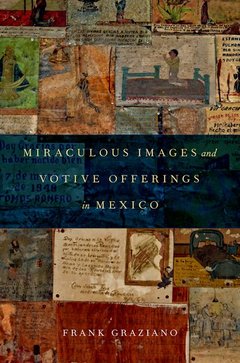Description
Miraculous Images and Votive Offerings in Mexico
Author: Graziano Frank
Language: English
Miraculous Images and Votive Offerings in Mexico
Publication date: 01-2016
352 p. · 23.9x16 cm · Hardback
Publication date: 01-2016
352 p. · 23.9x16 cm · Hardback
Miraculous Images and Votive Offerings in Mexico
Publication date: 01-2016
354 p. · 23.1x15.5 cm · Paperback
Publication date: 01-2016
354 p. · 23.1x15.5 cm · Paperback
Description
/li>Biography
/li>
Mexican statues and paintings of figures like the Virgin of Guadalupe and the Lord of Chalma are endowed with sacred presence and the power to perform miracles. Millions of devotees visit these miraculous images to request miracles for health, employment, children, and countless everyday matters. When requests are granted, devotees reciprocate with votive offerings. Collages, photographs, documents, texts, milagritos, hair and braids, clothing, retablos, and other representative objects cover walls at many shrines. Miraculous Images and Votive Offerings in Mexico studies such petitionary devotion--primarily through extensive fieldwork at several shrines in Guanajuato, Jalisco, Querétaro, San Luis Potosí, and Zacatecas. Graziano is interested in retablos not only as extraordinary works of folk art but: as Mexican expressions of popular Catholicism comprising a complex of beliefs, rituals, and material culture; as archives of social history; and as indices of a belief system that includes miraculous intercession in everyday life. Previous studies focus almost exclusively on commissioned votive paintings, but Graziano also considers the creative ex votos made by the votants themselves. Among the many miraculous images treated in the book are the Cristo Negro de Otatitlán, Niño del Cacahuatito, Señor de Chalma, and the Virgen de Guadalupe. The book is written in two voices, one analytical to provide an understanding of miracles, miraculous images, and votive offerings, and the other narrative to bring the reader closer to lived experiences at the shrines. This book appears at a moment of transition, when retablos are disappearing from church walls and beginning to appear in museum exhibitions; when the artistic value of retablos is gaining prominence; when the commercial value of retablos is increasing, particularly among private collectors outside of Mexico; and when traditional retablo painters are being replaced by painters with a more commercial and less religious approach to their trade. Graziano's book thus both records a disappearing tradition and charts the way in which it is being transformed.
Frank Graziano is John D. MacArthur Professor of Hispanic Studies at Connecticut College. His previous books include The Millennial New World, Wounds of Love: The Mystical Marriage of St. Rose of Lima, and Cultures of Devotion: Folk Saints of Spanish America.
© 2024 LAVOISIER S.A.S.




